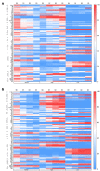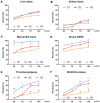Association of D-dimer elevation with inflammation and organ dysfunction in ICU patients with COVID-19 in Wuhan, China: a retrospective observational study
- PMID: 33591951
- PMCID: PMC7950237
- DOI: 10.18632/aging.202496
Association of D-dimer elevation with inflammation and organ dysfunction in ICU patients with COVID-19 in Wuhan, China: a retrospective observational study
Abstract
Coronavirus disease 2019 (COVID-19)-associated coagulation dysfunction is gaining attention. In particular, dynamic changes in the D-dimer level may be related to disease progression. Here, we explored whether elevated D-dimer level was related to multiple organ failure and a higher risk of death. This study included 158 patients with COVID-19 who were admitted to the intensive care unit (ICU) at Jinyintan Hospital in Wuhan, China between January 20, 2020 and February 26, 2020. Clinical and laboratory data were collected. The relationship between D-dimer elevation and organ dysfunction was analyzed, as were dynamic changes in inflammation and lipid metabolism. Approximately 63.9% of patients with COVID-19 had an elevated D-dimer level on ICU admission. The 14 day ICU mortality rate was significantly higher in patients with a high D-dimer level than in those with a normal D-dimer level. Patients with a D-dimer level of 10-40μg/mL had similar organ function on ICU admission to those with a D-dimer level of 1.5-10μg/mL. However, patients with higher levels of D-dimer developed organ injuries within 7 days. Furthermore, significant differences in inflammation and lipid metabolism markers were observed between the two groups. In conclusion, the D-dimer level is closely related to COVID-19 severity and might influence the likelihood of rapid onset of organ injury after admission.
Keywords: COVID-19; D-dimer; coronavirus disease 2019; critical care; organ dysfunction; retrospective study.
Conflict of interest statement
Figures






Similar articles
-
The inflammatory biomarkers profile of hospitalized patients with COVID-19 and its association with patient's outcome: A single centered study.PLoS One. 2021 Dec 2;16(12):e0260537. doi: 10.1371/journal.pone.0260537. eCollection 2021. PLoS One. 2021. PMID: 34855832 Free PMC article.
-
Clinical course and risk factors for mortality of adult inpatients with COVID-19 in Wuhan, China: a retrospective cohort study.Lancet. 2020 Mar 28;395(10229):1054-1062. doi: 10.1016/S0140-6736(20)30566-3. Epub 2020 Mar 11. Lancet. 2020. PMID: 32171076 Free PMC article.
-
Improvement in plasma D-dimer level in severe SARS-CoV-2 infection can be an indicator of fibrinolysis suppression: Case reports.Medicine (Baltimore). 2021 Apr 16;100(15):e25255. doi: 10.1097/MD.0000000000025255. Medicine (Baltimore). 2021. PMID: 33847623 Free PMC article.
-
Relationship of D-dimer with severity and mortality in SARS-CoV-2 patients : A meta-analysis.Int J Lab Hematol. 2021 Feb;43(1):110-115. doi: 10.1111/ijlh.13336. Epub 2020 Sep 15. Int J Lab Hematol. 2021. PMID: 32931146
-
The most important biomarker associated with coagulation and inflammation among COVID-19 patients.Mol Cell Biochem. 2021 Jul;476(7):2877-2885. doi: 10.1007/s11010-021-04122-4. Epub 2021 Mar 19. Mol Cell Biochem. 2021. PMID: 33742367 Free PMC article. Review.
Cited by
-
Evaluating the factors affecting clinical outcomes in critically ill COVID-19 unvaccinated patients admitted to the intensive care unit in a lower-middle-income country.Ann Med Surg (Lond). 2023 Nov 20;86(1):42-49. doi: 10.1097/MS9.0000000000001379. eCollection 2024 Jan. Ann Med Surg (Lond). 2023. PMID: 38222708 Free PMC article.
-
Prognostic Value of Routine Blood Parameters in Intensive Care Unit COVID-19 Patients.EJIFCC. 2022 Aug 8;33(2):121-130. eCollection 2022 Aug. EJIFCC. 2022. PMID: 36313910 Free PMC article.
-
Demystifying COVID-19 mortality causes with interpretable data mining.Sci Rep. 2024 May 2;14(1):10076. doi: 10.1038/s41598-024-60841-w. Sci Rep. 2024. PMID: 38698064 Free PMC article.
-
Hemoperfusion Combined With Continuous Renal Replacement Therapy in the Management of ARDS COVID-19 Patients: A Quasi-Experimental Study.Health Sci Rep. 2025 Apr 1;8(4):e70571. doi: 10.1002/hsr2.70571. eCollection 2025 Apr. Health Sci Rep. 2025. PMID: 40177411 Free PMC article.
-
Total triiodothyronine level associated with disease severity for patients with emergent status.Sci Rep. 2024 Jul 26;14(1):17170. doi: 10.1038/s41598-024-68195-z. Sci Rep. 2024. PMID: 39060337 Free PMC article.
References
-
- Helms J, Tacquard C, Severac F, Leonard-Lorant I, Ohana M, Delabranche X, Merdji H, Clere-Jehl R, Schenck M, Fagot Gandet F, Fafi-Kremer S, Castelain V, Schneider F, et al., and CRICS TRIGGERSEP Group (Clinical Research in Intensive Care and Sepsis Trial Group for Global Evaluation and Research in Sepsis). High risk of thrombosis in patients with severe SARS-CoV-2 infection: a multicenter prospective cohort study. Intensive Care Med. 2020; 46:1089–98. 10.1007/s00134-020-06062-x - DOI - PMC - PubMed
Publication types
MeSH terms
Substances
LinkOut - more resources
Full Text Sources
Other Literature Sources
Medical

